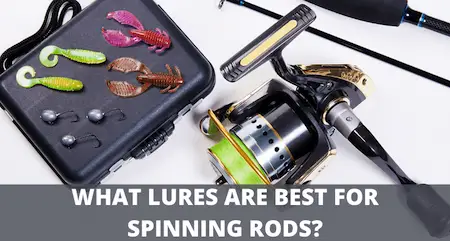What Lures Are Best For Spinning Rods?
UPDATED 17 MAY 2023
by Robert Ceran
If you’re planning to use a spinning rod setup, you need to know what lures are best for spinning rods.
Choosing the right lures for your rod can be challenging because different rod types perform better with different lure types, and also with different lure sizes.
For example, large spinnerbaits, jigs, and crankbaits are best suited for baitcasting rods, since casting rods perform best with heavy lures, and not so well with smaller, lightweight lures.
On the other hand, if you want to throw ultra light finesse lures, a spinning rod will serve you much better than a casting rod.

If you’re interested in using these kinds of tactics for bass fishing, check out the following guide: what is the best spinning rod for bass?
In this article we’ve summarized the most important kinds of lures to use with a spinning rod setup, and how to match the right lure size with your rod.
What kinds of lures are best for spinning rods?
In general, spinning rods are best suited for lightweight lures and finesse tactics.
In terms of lure weight, anything that weighs less than 1/4 oz is generally better suited for a spinning rod, while anything heavier than this is better suited for a casting rod (though there’s quite a bit of overlap in the middle of the range).
Below is an overview of the lure types that are best for spinning rods:
Finesse lures
- Micro jigs
- Ultra light poppers
- Ultra light swimbaits
- Small tubes
- Small spoons
Soft plastic lures
- Wacky worms
- Shaky heads
- Finesse worms
- Ribbon tail worms
- Soft plastic swimbaits
- Plastic stick baits
- Soft plastic craws
All of these lures have in common that they are lightweight, which means you can throw them a lot further with a spinning rod compared to a casting rod (even if you’re using weighted jig heads).
Another advantage of using a spinning rod for these lures is that they are much more sensitive, especially if you maintain direct contact with the rod blank with your hand.
That way you can feel very subtle bites, which are very common when using these baits.
Finesse rigs
- Drop shot rig
- Ned rig
- Neko rig
The rigs above tend to be on the lightweight side, since they use small weights, and low pound test fluorocarbon lines to avoid shy fish spotting your fishing line.
Lightweight rigs like this can be cast much further with a spinning rod, plus the sensitivity of a spinning setup will help you to feel the smallest tugs and subtle nudges on your bait from finicky biters.
Lures that can be used with either spinning or casting rods
- Topwater lures
- Jerkbaits
- Crankbaits
- Tubes
While spinning rods definitely perform better with lightweight lures compared to baitcasting rods, both rod types can be used for lures in the medium weight range (1/4 to 1/2 oz), and which rod type you choose is largely determined by your preference.
Some bass anglers are so skilled with their baitcasting setups that they can use them to throw lightweight lures down to 1/4 oz (though a spinning setup still has the added advantage of being more sensitive).
If you’re not sure which brand of lures are best for you, check out our article on the top 20 fishing lure brands.
Matching lures to rods
Once you decide which lures to use with your spinning rod, you still need to make sure to match the right lure weight with your rod. The best way to do this is to check the lure weight on the rod handle.
Almost every fishing rod has a series of numbers written on its blank, usually right above the handle. One of these numbers tells you what lure weight works best for that rod.
The lure weight on a rod is usually given as a range (for example: 1/8 to 3/8 oz).
Just make sure that your lure weight falls within this range, or at least comes close to it. In case you’re assembling lures by rigging soft plastics onto weighted jig heads, you can estimate their weight based on adding a small amount to the weight of the jig head.
Choosing the right lure weight for your spinning rod is essential for improving casting performance, since the ideal lure weight will load the rod perfectly during the casting process.
The loading behavior of a rod depends on the power and action of its blank, and if you want to use lures that are outside of its weight range, it’s better to choose another rod with different loading behavior.
For more detailed information on how to match all components of your rod and reel setup with each other, check out this article: spinning rod setup for bass.
Final remarks
In conclusion, spinning rods are best for throwing lightweight to ultra light lures or finesse rigs, so any lure that falls in this size category is best used with a spinning rod.
In addition to having greater casting distance with lightweight lures, spinning rods also outperform casting rods in terms of rod sensitivity, which is essential for fishing with lightweight lures.
